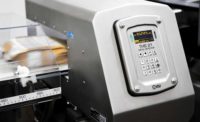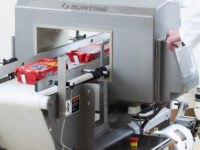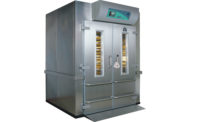Inspection/detection continues to advance in the snack and baking industry
X-ray, metal detection, checkweighing and vision systems improve quality control

X-ray, metal detection, checkweighing and vision systems continue to advance, offering bakery and snack producers many ways to improve their quality control programs.
One of the most-important developments in inspection systems has been the increasing number of combination systems. Any of the four basic types of systems (checkweighing, metal detection, X-ray and machine vision) can be combined in a single system. “This saves production space and reduces cost while simplifying the inspections needed to ensure product safety,” says Lanel Menezes, business manager, Safeline X-ray, Mettler Toledo Product Inspection, Tampa, FL.
In fact, X-ray inspection and metal detection have proven to be complementary technologies. “The strength of X-ray is its ability to find non-metallic contaminants and provide acceptable detection for packages that contain metal or metal film. Metal detection’s advantage is that it’s 50 percent less expensive than X-ray while its simpler design makes it a more robust solution that lasts longer,” says Bob Ries, lead product manager, metal detection and x-ray inspection, Thermo Fisher Scientific, Waltham, MA.
Bakery and snack producers can use X-ray, metal detection and vision systems individually or in combination to eliminate products that contain metal, glass, plastic or even accidental allergens, according to Steve Gidman, president, Fortress Technology Inc., Toronto. “Each system has its own benefits and drawbacks. For instance, X-ray systems generally cannot be used on free-falling products because of the inconsistent density within the falling product stream. This rules them out of many snack bagging operations, such as vertical form/fill/seal lines. Meanwhile, metal detectors cannot detect stone, glass, high-density plastics or bone.”
X-ray options
In recent years, experts agree that X-ray systems have evolved by increasing the detection capability of the X-ray detector, thereby allowing a reduction in the power requirements of the X-ray generator. Reducing power requirements reduces the need for costly cooling equipment.
X-ray technology has evolved to offer not only superior contaminant detection, but actionable information that improves product safety as well as operational efficiency and traceability, according to Christy Draus, marketing manager, Eagle Product Inspection, Tampa, FL. “There have been major advances in image analysis software that facilitate enhanced detection and removal of foreign materials. For example, Eagle’s SimulTask PRO image analysis software provides the widest grayscale in the industry. The denser the object, the more dark gray will appear in the image; it’s easier to identify contaminants with more shades of gray.”
Improvements also have been made in single-energy and dual-energy, Draus adds. “Eagle’s dual-energy Material Discrimination X-ray (MDX) technology is used to inspect challenging products, identifying materials by their chemical composition. Dual-energy MDX technology overcomes limitations of interpreting a grayscale image, making inorganic contaminants easier to identify in ‘busy’ images.”
The Ishida IX-GN Series X-ray inspection system, available from Heat and Control Inc., Hayward, CA, offers seven-step image analysis technology that simultaneously detects foreign objects. Standard features include defect inspection, a masking feature which factors in individual product attributes that may cause false positives, and weight estimation. “The GN Series offers versatile detection settings that cater to exact inspection requirements,” says Todd Grube, product manager, inspection systems. Ishida also offers the IX-EN Series X-ray inspection system, which provides a basic level application with a lower voltage X-ray tube.
Metal detectors
Eriez, Erie, PA, continues to focus on improving metal detector sensitivity through enhanced signal processing algorithms and specialized coil architectures, according to Ray Spurgeon, metal detector product manager. “Our customers are requesting smarter equipment that communicates with the production line. This includes features such as software that prompts users for testing and capabilities for electronic recordkeeping and reporting.”
Eriez recently introduced Xtreme Vertical Drop Metal Detectors, which detect the presence of ferrous, nonferrous and stainless metal contaminants in gravity free-fall applications in bakery and snack processing. Available in wall- or floor-mount designs, they strike a balance between absolute detection of all metal contaminants and elimination of false signals that slow down production. They also offer easy set-up and reporting as well as remote access capabilities.
Bunting, Newton, KS, has introduced Triple Frequency technology to its metal detectors, which improves the product learning process. It also returns the sensitivity available at each frequency, and allows the operator to select an alternate frequency if needed. “This is set up for every product, so if you have products with different properties it allows the proper frequency to be utilized for each one,” says Barry Voorhees, metal detection product manager.
Bunting also has developed an autoTEST feature, which allows the metal detector to perform sensitivity tests automatically, based on the customer’s auditing requirements without having to physically pass test pieces through the coil and interrupt production.
Mettler Toledo Product Inspection has introduced GC Series conveyorized metal detection systems that offer a highly configurable design that can adapt to the changing requirements of the food industry. They can be supplied with a variety of Safeline metal detectors, polyurethane or modular belts, and various reject mechanisms.
“We know the benefits a metal detector can bring to a production line; however, having an integrated conveyorized metal detection system provides far greater benefits. With a complete solution from the same supplier, bakery and snack producers know their metal detection system is fully compliant with food safety legislation and retailer requirements,” says Mike Bradley, product inspection specialist.
Checkweighers and more
Reiser, Canton, MA, has introduced the VPC715, the first checkweigher designed for high-speed bakeries, according to John McIsaac, vice president of strategic business development. Designed for bakeries that use the Vemag dough divider, the VPC715 automatically steers the divider to compensate for dough density changes throughout a batch. “The VPC715 can steer the divider as the product changes over the course of large batches, or when the product is on the floor longer than expected. It communicates directly with the dough divider, continuously fine tuning each dough portion to fine tune the weights, without operator intervention,” McIsaac explains.
Thermo Fisher Scientific has introduced a combination checkweighing and metal detection system. The Sentinel 3000 is a Multiscan metal detector that fits directly on the frame of the checkweigher. The checkweigher software has been improved so that the user interface is compatible with the metal detector, reducing training time and improving ease of use. “Combination systems are ideal at the end of the line because they save space and are at least 20 percent less expensive than two dedicated systems,” Ries notes.
According to Ries, metal detectors such as Thermo Fisher’s Sentinel have evolved to use a wide spectrum of energy to detect previously undetectable contaminants: “Advanced electronics and software have made this possible.”
Vision systems
Sightline Process Control Inc., a KPM Analytics company, Ottawa, Ontario, is now delivering its second generation vision inspection systems featuring enhancements like more imaging options, LED lighting, improved frame design, new rejection options, and ever-evolving software features, says Tammy Morrison, marketing manager.
“The new frame design, available in a full washdown configuration, offers a sleeker appearance while occupying less space, making it easier to install onto existing lines and offering greater flexibility when designing a new line,” says Morrison. “The carefully planned angles aid in the mitigation of dust collection for easier cleaning.”
Multi-camera configurations, including thermal, IR and higher-resolution imaging options, are now available with Sightline’s inspection systems, notes Morrison.
Sightline systems can also detect color differences. “Brioche buns, in particular, are very popular with consumers for their rich taste, and we’ve seen a sharp rise in production amongst bakeries supplying large foodservice franchises,” says Morrison. Sightline systems are able to detect subtle differences in color by applying the standards to each object measured.
Digital sorters
Key Technology, Walla Walla, WA, offers VERYX digital sorters that can be equipped to achieve all-sided surface inspection, which maximizes foreign material (FM) and defect detection. The next-generation four-channel cameras and laser scanners available on VERYX digital sorters offer twice the resolution of previous sensor technology, according to Karel Van Velthoven, advanced inspection systems product marketing manager.
As snack food processors strive to optimize their product quantity while maximizing production efficiencies and yield, they are looking to increase line control. To help them achieve this, Key Technology offers information analytics that enable food processors to better manage raw materials and improve processes upstream and downstream of the sorter. “Information analytics can be used to continuously collect and analyze information about the product flowing through the production line,” Van Velthoven says. “It also allows processors to share this data across their enterprise.”
Looking for a reprint of this article?
From high-res PDFs to custom plaques, order your copy today!






